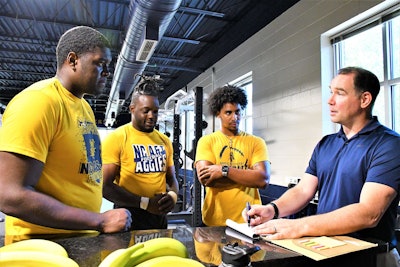Low-energy availability (LEA) and high blood pressure (HBP) in Black athletes may be related, according to findings from a recent study from North Carolina Agricultural and Technical State University (N.C. A&T). Student athletes Jason Ivey, Janorris Robertson, and Zach Yeager, and Dr. Troy Purdom
Student athletes Jason Ivey, Janorris Robertson, and Zach Yeager, and Dr. Troy Purdom
The small pilot study analyzed the self-reported nutritional intake of 23 Black N.C. A&T Division I athletes – 13 male students, 10 female students – spanning sports, such as track and field, basketball, football, and volleyball.
“To our knowledge, this is the first study to evaluate the nutritional influence on HBP and separately the first to consider Black athletes,” the study authors wrote.
Researchers discovered a “moderate relationship” between cardiovascular disease and LEA, the latter defined in the study as someone intaking less energy than needed for their estimated daily energy use. More than half (14 of 23) of the athletes were found to have LEA, according to the study. And among those 14, high blood pressure was more prevalent (78.6%) than among the 9 students without LEA (22.2%).
Of the nutrients examined in the study – which included those with known cardiovascular effects – there were deficiencies across the board, said Dr. Troy Purdom, study principal investigator and an assistant professor in N.C. A&T’s kinesiology department. He added that that deficiencies of this nature have significant impacts on cardiovascular systems beyond just energy deficiency.
“Nutrient deficiencies were ubiquitous, which means that every nutrient we explored was deficient,” Purdom said. This means the athletes were found to be deficient in carbohydrate, protein, fat, polyunsaturated fatty acids, Omega3, sodium, calcium, Vitamin D, and iron.
This indicates that these student athletes were not only eating enough, but also not eating the right nutritional foods, Purdom said.
High blood pressure – also known as hypertension – is the second most prevalent cardiovascular disease in athletes, Purdom said.
"Previous literature has shown that once you develop hypertension, the likelihood of you developing hypertension again within five years doubles,” Purdom said. “So if we're seeing this in young, seemingly healthy athletes, the likelihood that they will develop hypertension later in life within five years is significantly concerning."
Athletes are faced with several barriers to eating well, including limited schedules and insufficient nutritional knowledge, Purdom said.
"One of the barriers to nutrition in athletes is just nutritional knowledge, so just having a general understanding, the vocabulary to be able to understand what your body needs,” Purdom said. “In much of the athletic culture, there is dialogue pertaining to 'you need to eat more.' And that's repeated across a variety of different coaches."
But what's fascinating, he added, is that, in many cases, athletes don't understand what their body needs.
"So when we say, ‘eat more,’ they don't know how much, they don't know what to eat," Purdom said, adding that there are plans to extend this research into a larger study that examined the current findings, nutritional deficiencies and cardiovascular disease, and the various factors that may be in play, such as social determinants.
Researchers are also attempting to obtain data from other studies to investigate racial components, he said. The risk of cardiovascular disease is 10 times greater for Black athletes than white athletes.
These findings may also speak to the lack of food access, said study co-author Lauren San Diego, a graduate student at N.C. A&T.
"What's interesting with this population is it's an HBCU, and the surrounding area is a food desert,” San Diego said. “So I think this speaks to a larger problem of food access in general."
The study’s other co-authors included Dr. Heather Colleran, an associate professor in food and nutritional sciences; Dr. Paul Stewart, a biostatistics professor emeritus at the University of North Carolina at Chapel Hill; and Dr. Marc Cook, associate director for N.C. A&T’s Center of Excellence in Integrative Health Disparities and Equity Research.
"The study was really birthed out of getting the athletes resources,” Cook said. “And I think what Dr. Purdom's study has really done [is] really shine a light on what types of resources are needed for these student athletes to be at their best."





















